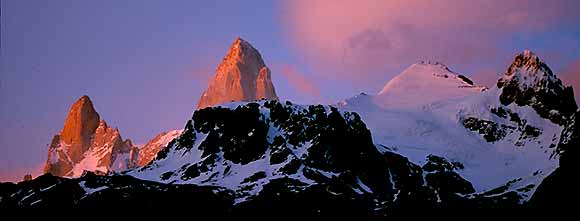| Cloud Ridge Naturalists 2 0 0 4 | ||||
 |
||||
| Fitz Roy massif, photo Audrey Benedict | ||||
| Ancient Forests & Steppes of the Andes: A Naturalist's Journey to Northern Patagonia |
||||
|
C O N T E N T S
|
||||
|
HOME PAGE / INTRODUCTION LATE 2004 ISLAND DREAMS: A Catalyst Voyage to British Columbia's Discovery Coast ANCIENT FORESTS & STEPPES OF THE ANDES: A Naturalist's Journey to Northern Patagonia 2005 OF TIGER WALLS & CANYON WRENS: A Naturalist's Journey on the Yampa & Green Rivers IMAGES OF WILDERNESS: Southeast Alaska's Outer Coast aboard the MV Snow Goose RAFTING THE HULAHULA: A River Journey through the Arctic National Wildlife Refuge VOYAGE TO THE LAND OF THE ICE BEAR: A Circumnavigation of Svalbard (Spitsbergen) BERING SEA EXPEDITION: Russia's Kamchatka Peninsula, the Aleutian Archipelago, and the Pribilofs |
November 12-December 5, 2004 Leaders: Carol and Carlos Passera, Daniel Feinstein, Dee Boersma, Marcelo Aizen, Andrea Premoli, Thomas Kitzberger, Marcela Ferreya, Adan Hajduk, Martin Funes, and Javier Sanguinetti For the naturalist, the spectacular cordilleras and windswept steppes of Patagonia need little introduction. Neither nation nor state, Patagonia encompasses the vast region at the tip of South America that stretches from the Atlantic to the Pacific and straddles two countries, Argentina and Chile. Northern Patagonia is truly a land of ecological extremes — immense continental icefields, dramatic wind-sculpted spires that rank among the world’s most challenging summits, lush temperate forests, turquoise-blue lakes and fjords, and desert-like steppes. At this latitude (40º S), the Andean Cordillera forms such an effective barrier to the dominant westerly air masses that sweep across the Pacific that they create one one of the steepest rainfall gradients in the world. As you move eastward from the Andean crest, annual precipitation decreases from 3000 mm to less than 500 mm in a distance of less than 80 km — high elevation, cool-temperate rainforests give way to progressively drier forests dominated by one or several species of southern beech (Nothofagus) and finally to the extremely arid Patagonian steppe.
|
|||
 |
||||
| The view from Hosteria El Pilar, photo Audrey Benedict | ||||
|
We’ll fly north from El Calafate to San Carlos de Bariloche, where we’ll take a boat trip across Lago Nahuel Huapi to a lovely mountain lodge situated in the heart of Valdivian rainforest, at Puerto Blest, in Parque Nacional Nahuel Huapi. Biologists from the Temperate Rainforest Biological Station will join us here for an in-depth look at the flora and fauna of these extraordinary forests. Ancient alerces (Fitzroya) and towering beeches rise majestically above an almost impenetrable understory of Chusquea bamboo, golden-flowered Berberis darwinii, and magenta and lapis-colored Fushia magellanica. It is easy to see how these luxurious forests could harbor several secretive and endangered species, such as the Andean tapaculo, the huet-huet, the púdú (a dwarf deer), the Patagonian river otter, and the “monito” del monte (a tiny arboreal marsupial with a fondness for mistletoe berries). Moving northward along the east slope of the Andes, to Parque Nacional Laguna Blanca, we’ll visit a shallow alkaline lake beneath snow-capped Volcán Laní. The lake provides critical habitat for black-necked swans, Chilean flamingos, upland geese, and many other species. We’ll explore nearby Parque Nacional Lanín, where the foothill forests are dominated by two of the rarest trees in Patagonia — the curious pehuén or monkey-puzzle tree (Araucaria araucana), a bizarre looking confer, and the small, deciduous raulí, a broadleaved beech (Nothofagus nervosa). A visit to the Mapuche Indian Reservation at Rucachoroi will reveal the lifeways of the Pehuenche and Mapuche people, for whom the nut of the pehuén was a dietary staple. We’ll travel north to the high elevation pass of Las Cuevas and our first view of Aconcagua, the highest peak in the Americas. Dropping down into the semiarid heartland of the Mendoza Province — a region known as “La Tierra del Sol y Buen Vino" (Land of Sun and Good Wine) — we’ll soon see that enough snowfall accumulates on Aconcagua’s eastern slopes to sustain the rivers that feed the irrigation systems of the lowlands. Mendoza is justifiably famous for its extensive vineyards and fine wines, and we’ve planned time for a vineyard visit, some wine tasting, and a farewell asado. From the marine riches of the coast, the cool rainforests and magnificent alpine areas of the southern Andes, to the fanciful monkey-puzzle forests and desert-like steppes of the Andean foothills, there is something of interest for everyone—and all set against some of the most magnificent scenery on earth. Group Limit: 16 Trip Rating: 3 Price: $6,400 ($800 deposit to reserve space) This trip is currently full. Wait-list inquiries are welcome. |
||||
|
Contact:
|
Cloud Ridge Naturalists 8297 Overland Road Ward Colorado 80481 email > cloudridgeadb@earthlink.net |
|||
 Our ecological journey will begin on the Peninsula Valdés, along the Atlantic, where we’ll observe southern right whales in Golfo Nuevo and explore the coastal steppe, home to enormous colonies of Magellanic penguins, noisy rookeries of southern elephant seals and other sea mammals, herds of guanaco, family groups of ostriche-like rheas, ground-dwelling maras, and a multitude of sea and shorebirds. Traveling westward to the foothills of the Andes, we’ll spend two days hiking Mt Fitzroy’s beautiful trails, and if the weather gods permit, enjoy fabulous views from Lago de los Tres, a jewel-like tarn that lies in the shadow of these legendary spires. The magnificent old-growth beech forests that we’ll see here provide critical habitat for birds such as the Magellanic woodpecker, Chilean flicker, Austral parakeet, Chilean swallow, and white-throated treerunner.
Our ecological journey will begin on the Peninsula Valdés, along the Atlantic, where we’ll observe southern right whales in Golfo Nuevo and explore the coastal steppe, home to enormous colonies of Magellanic penguins, noisy rookeries of southern elephant seals and other sea mammals, herds of guanaco, family groups of ostriche-like rheas, ground-dwelling maras, and a multitude of sea and shorebirds. Traveling westward to the foothills of the Andes, we’ll spend two days hiking Mt Fitzroy’s beautiful trails, and if the weather gods permit, enjoy fabulous views from Lago de los Tres, a jewel-like tarn that lies in the shadow of these legendary spires. The magnificent old-growth beech forests that we’ll see here provide critical habitat for birds such as the Magellanic woodpecker, Chilean flicker, Austral parakeet, Chilean swallow, and white-throated treerunner.